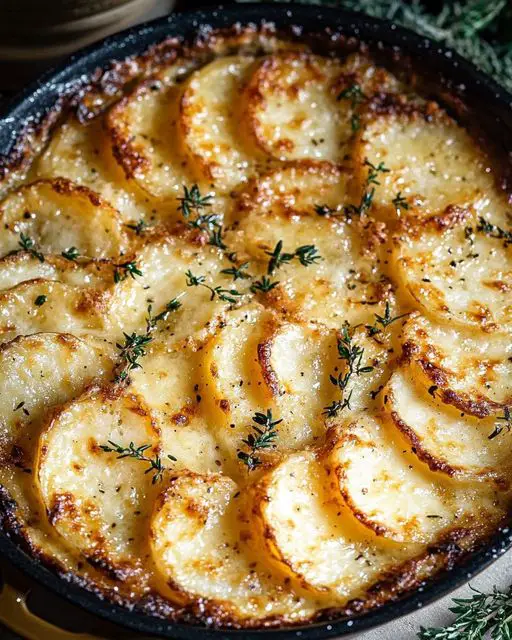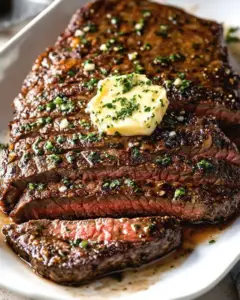Crispy Parmesan and Gruyere Potato Gratin: A Deliciously Cheesy Delight
Experience the exquisite flavors of Crispy Parmesan and Gruyere Potato Gratin, a dish that effortlessly combines cheesy richness and crispy textures. This elegant side dish is perfect for both family dinners and festive gatherings, offering a harmonious blend of creamy parmesan, nutty gruyere, and tender potatoes. Prepare to tantalize your taste buds with this brilliant potato gratin recipe that promises comfort and delight in every bite.
Crispy on the outside and soft on the inside, the golden-crusted gratin is layered with velvety slices of potatoes, seasoned to perfection. Enveloping the gratin are the inviting aromas of baked cheese and herbs, creating an intoxicating scent that wafts through your kitchen. Each forkful delivers a satisfying crunch followed by the smooth and savory notes of parmesan and gruyere, leaving an unforgettable impression on your palate.
Quick Recipe Highlights
- Flavor Profile: The Crispy Parmesan and Gruyere Potato Gratin features a delightful combination of cheesy richness with a hint of garlic and herbs, creating a well-rounded savoriness.
- Texture: This gratin offers a pleasing contrast, with a perfectly crispy top layer and a soft, creamy potato interior.
- Aroma: Expect enchanting notes of melting cheese, fresh thyme, and roasted potatoes, filling your kitchen with warmth and comfort.
- Visual Appeal: A beautifully golden, bubbling top layer makes this gratin eye-catching and appetizing.
- Skill Level Needed: Intermediate cooking skills are recommended, involving slicing and layering techniques.
- Special Equipment: A mandoline slicer for uniform potato slices is advised, along with a reliable ovenproof dish.
Recipe Overview
- Difficulty Level: The Crispy Parmesan and Gruyere Potato Gratin is labeled as intermediate due to the precision needed in slicing and layering the potatoes evenly for consistent cooking.
- Category: This dish belongs to the category of comforting side dishes, perfectly complementing a variety of main courses.
- Cuisine: Drawing from French influences, this gratin echos classic French techniques and flavors while remaining accessible to modern cooks.
- Cost: With readily available ingredients like potatoes, cheese, and cream, this dish offers luxury without breaking the bank.
- Season: Best suited for fall and winter months when warming, hearty dishes are celebrated for their comforting qualities.
- Occasion: Perfect for holiday parties, family gatherings, or as a delightful accompaniment to a Sunday roast.
Why You’ll Love This Recipe
The Crispy Parmesan and Gruyere Potato Gratin seduces with its layers of gourmet flavors and textures. Cheese enthusiasts will revel in the pairing of sharp parmesan and nutty gruyere, each bite offering a heavenly melt-in-the-mouth experience. The crisp topping provides a dynamic contrast to the creamy potato layers, ensuring this dish remains an adventurous delight.
Despite its gourmet impression, this gratin maintains the convenience of a straightforward preparation. Slicing the potatoes in advance allows for smoother assembly, while the baking time offers the perfect window to focus on preparing other meal elements. For those who relish in meal planning, this dish can be prepped ahead of time and baked just before serving.
Packed with nutrients, potatoes serve as an excellent source of vitamins, minerals, and fiber, while the cheese adds a rich source of calcium and protein. This blend of ingredients culminates in a gratin that doesn’t just satisfy but nourishes as well, making it a great choice for balance-conscious enthusiasts.
Embodying social and entertaining value, the golden-crusted gratin is sure to become the centerpiece of your dining table. It invites conviviality, as guests delight in sharing and experiencing its lusciousness. Its visual appeal speaks volumes, establishing it as a conversation starter.
Designed with accessibility in mind, the Crispy Parmesan and Gruyere Potato Gratin can be made with moderately priced ingredients, making it feasible for regular households without straying far from their budget constraints. The ability to find alternative cheese options enables flexibility and adaptability without sacrificing quality.
Historical Background and Cultural Significance
The origin of potato gratins hails from the culinary traditions of France, where this style of cooking is deeply rooted. A staple in French cuisine, the gratin method highlights the French love for textures and layers, exemplified in their world-renowned patisserie as well as savory dishes.
Throughout history, potato dishes have played a crucial role in regional cooking, not just as a food source, but also as a testament to reflective cooking techniques that prioritize both flavor and elegance. Potato gratins reflect a tradition of layering flavors and textures, transforming simple ingredients into a sophisticated dish.
The Crispy Parmesan and Gruyere Potato Gratin is an iteration that marries historical context with contemporary flair. Cheeses like gruyere and parmesan introduce a luxurious twist to the classic gratin, appealing to modern palates that crave depth.
Regional variations abound, with some areas opting for the addition of cream and others a bechamel base. Such diversity showcases the adaptability and enduring allure of the gratin form across different cultures and tastes, illustrating its evolution from a rustic staple to a sophisticated offering.
Ingredient Deep Dive
Potatoes are the heart of any gratin, offering versatility in taste and texture. Historically, potatoes have been a vital crop throughout the world, revered for their ability to sustain and provide satiety. They’re nutritionally dense, rich in potassium, vitamin C, and dietary fiber, making them an ideal base for any wholesome dish.
Storability adds to their charm, allowing potatoes to be stored in a cool, dark place, making them accessible for meal planning. When selecting potatoes for gratin, opt for varieties that hold their shape well when cooked, such as Yukon Golds. Substitutions like sweet potatoes can provide creative and flavorful alternatives.
Gruyere cheese brings its distinctive nutty flavor and creamy consistency to the gratin. Known for its origins in the Swiss region that bears its name, gruyere is a traditional cheese used frequently in a variety of global dishes, from fondues to pasta. Its ability to melt evenly and create a desirable crust makes it a natural fit for gratins.
When incorporating gruyere, look for authentic wheels that give rich, complex flavors, ensuring a cheese color ranging from pale yellow to golden. Store it in a refrigerator wrapped tightly in cheese paper or waxed paper to maintain its freshness. For an alternative, you might experiment with a comté or aged cheddar to keep cost-effective yet flavorful options.
Common Mistakes to Avoid
- Slicing potatoes unevenly can lead to inconsistent cooking times. Always aim for uniform slices to ensure even baking throughout.
- Over-baking can turn the potatoes mushy and affect the gratin’s creamy texture. Monitor the dish closely towards the end of the suggested cook time.
- Not using a mandoline slicer or sharp knife may result in thick, uneven potato slices, impacting the dish’s overall texture.
- Neglecting to season each layer properly might result in a bland gratin; make sure to sprinkle salt and pepper generously between layers.
- Using pre-grated cheese can lead to a less-than-smooth sauce, as it contains anti-caking agents that impede melting. Stick to hand-grated cheese for the best results.
- Skipping the resting phase after baking can lead to a runny gratin. Allowing the dish to sit for at least 5-10 minutes helps the ingredients settle.
- Forgetting to dab the potatoes dry before cooking can introduce excess moisture, preventing the topping from becoming crisp. Pat them dry with paper towels if needed.
- Adding the cheese layer too early might cause it to burn. Monitor the dish closely and add extra cheese halfway through the baking process to prevent burning.
Essential Techniques
Mastering the slicing technique is vital for this gratin. Evenly sliced potatoes ensure uniform cooking, promoting a creamy consistency throughout. Using a mandoline slicer can simplify this process, providing the necessary precision. However, always exercise caution when handling sharp equipment to avoid accidents.
Layering plays a significant role in the gratin’s success. Balance is key; avoid excessively stacking layers to maintain a smooth and integrated texture. Aim for neat, even layers, ensuring each potato slice is evenly coated with cheese and seasonings to avoid dry spots or flavor inconsistency.
Cooking the gratin requires both patience and attentiveness. Pre-cooking the potatoes slightly in seasoned cream before assembling infuses them with flavor, enhancing overall aroma and taste. This additional step elevates the dish from a simple baked potato to a luxuriously rich gratin.
The visual cues for a successful gratin include a golden-brown crust, bubbling edges, and a slightly firm texture when prodded gently with a fork. These indicators confirm the balance of doneness and creaminess, reflecting a precise handling of time and temperature.
Pro Tips for Perfect Crispy Parmesan and Gruyere Potato Gratin
To prevent burning, cover your gratin with foil halfway through the baking process, allowing for gradual browning. Use quality cheese; authentic gruyere imparts depth of flavor and ensures superior melt quality compared to processed alternatives.
Add a dash of nutmeg to the cream for an earthy depth that complements the cheese and potatoes brilliantly. Introduce a fresh herb garnish, like parsley or chives, after baking for enhanced freshness and pop of color.
If the topping isn’t crisp enough, broil the dish for an additional minute or two at the end of baking for a perfect golden finish. Test for doneness by inserting a knife—it should meet no resistance if the potatoes are fully cooked.
Allow the gratin to rest for 10-15 minutes before serving. This resting phase stabilizes the cream, facilitating cleaner slices and enhancing flavor cohesion.
Include a small amount of garlic, minced finely, for subtle aromatic hints that accentuate the dish’s savory profile without overpowering the cheese.
Avoid using potatoes that have started to sprout, as the sprouts can introduce a bitter taste. Always store potatoes in a cool, dark, well-ventilated place to maintain their quality and taste.
Variations and Adaptations
For regional variations, consider infusing the gratin with Mediterranean influences by incorporating roasted red peppers and crumbled feta cheese. The result is a bold, vibrant adaptation that maintains the core gratin attraction while introducing new dimensions of flavor.
Seasonal adaptations could involve using root vegetables like sweet potatoes or parsnips for a fall-inspired twist. The natural sweetness of these vegetables pairs beautifully with the traditional cheeses, offering a heartening alternative to the classic.
For dietary modifications, a vegan adaptation utilizing cashew cream and nutritional yeast can deliver an equally satisfying, plant-based option. When pursuing low-carb diets, swap traditional potatoes with cauliflower florets to recreate the gratin’s allure with reduced carbohydrates.
Texture modifications can enhance the culinary experience; a smattering of chopped nuts over the top layer can introduce a delightful crunch, juxtaposed against the gratin’s intrinsic creaminess.
Presentation alternatives include using individual ramekins for personalized servings or garnishing with microgreens for an elegant, sophisticated look that enhances both aroma and taste.
Serving and Presentation Guide
When plating this gratin, utilize contrasting colors to draw the eye. Garnish each serving with fresh herbs or edible flowers for a pop of color and enhanced flavor profile. Consider pairing the gratin with leafy greens, like arugula, to introduce contrast in texture and freshness, balancing the gratin’s richness.
Traditional accompaniments like a lightly dressed salad or a crisp vinegar-based coleslaw work exceptionally well, offering a palate-cleaning counterpoint to the gratin’s creaminess.
Modern serving suggestions might involve constructing the gratin within ring molds for a chic, structured presentation or serving it as a topping for gourmet bruschetta at social gatherings.
Temperature considerations suggest serving the gratin warm, as it’s meant to be enjoyed fresh from the oven, while resting ensures the structure remains intact.
Portion control tips recommend serving slices cleanly, using a sharp knife to cut precise squares or wedges, allowing each guest a balanced experience of the crunchy top and creamy interior.
Wine and Beverage Pairing
For an indulgent pairing, select a medium-bodied white wine like a Chardonnay, whose buttery notes complement the creamy gratin. Alternatively, a red wine such as a light Pinot Noir offers a delicate contrast with mild tannins, enhancing the savory cheese profile without overpowering it.
Non-alcoholic alternatives include a sparkling water infused with citrus twists or a rosemary sprig, providing refreshing, sophisticated hydration alongside this rich dish.
If coffee or tea is your preference, consider an earthy green tea to accompany the gratin, providing a mellow balance to its substantial flavors. Temperature considerations should keep beverages light and slightly chilled to refresh the palate after tasting creamy layers.
Serving suggestions recommend maintaining a neutral palate with your beverage choice, ensuring it complements but never overshadows the intricate flavors of the gratin.
Storage and Shelf Life
Store leftover gratin by covering it tightly with plastic wrap and refrigerating it for up to three days. Ensure the dish is cooled to room temperature before storing, preserving texture and flavor.
Containers must be airtight to prevent absorbing external odors. Clear Pyrex dishes or well-sealed glass containers work nicely. Avoid using aluminum foil if planning to reheat the gratin directly in the container—transfer to a microwavable or oven-safe dish instead.
Reheating instructions recommend warming the leftover gratin at a low temperature in the oven, around 325°F (165°C), for roughly 20 minutes.
Freezing guidelines suggest storing pre-baked gratin sealed securely in a freezer-safe dish. Freeze up to a month, thaw overnight in the refrigerator before reheating on a low oven heat to avoid uneven thawing or textural changes.
Make Ahead Strategies
Prep the potatoes and sauce in advance, storing components separately. Potatoes can be thinly sliced and submerged in water to preserve color, while sauce ingredients can be mixed and refrigerated up to two days ahead.
Storage between steps is crucial—evacuate all air when storing sauces by filling containers as fully as possible. Minimize dew from forming and preserving ingredient integrity.
Assembly tips recommend layering the gratin shortly before baking to keep ingredients fresh. Crisp topping ensures the finished product garners the quintessential gratin texture.
Reheating guidelines suggest bringing refrigerated ingredients to room temperature before baking to ensure even cooking.
Add fresh elements like herbs or final cheese sprinkles just before serving to enliven the dish with pop and fragrance, reinforcing freshness.
Scaling Instructions
Halving the recipe is straightforward—simply divide ingredient quantities appropriately. Adjust pan size accordingly to ensure proper cooking depth is maintained, with a slightly shorter baking time needed for smaller volumes.
Doubling or tripling demands precise calculations. Ensure your ovenware is equipped to handle expanded volumes—utilize multiple dishes if required to avoid overcrowding or uneven cooking.
Equipment adjustments include using larger casserole dishes or baking trays lined with parchment to accommodate expanded layers, aiding in even browning and ease of serving.
Timing modifications require an attentive eye. Larger batches may extend cooking times—watch the gratin carefully, ensuring golden browning while retaining a creamy core.
Storage considerations suggest portioning into smaller, measured containers for adaptability across meals, affording quick access without compromising the integrity of the main dish.
Nutritional Deep Dive
With a balanced macro breakdown of carbohydrates from potatoes, proteins from cheeses, and fats from cream, this gratin presents a well-rounded nutritional profile.
Micronutrient analysis highlights its contribution of calcium and vitamin D from cheeses, plus potassium and vitamin C from the potatoes.
Health benefits stem from moderate servings, providing necessary nutrients in an accessible, enjoyable form that suits varied dietary requirements.
Dietary considerations for lactose intolerant or gluten-free adaptations ensure inclusivity by selecting compatible cheese options and reflecting on ingredient substitutions.
Portion analysis suggests individual servings to contain around 250-300 calories, acknowledging diverse dietary needs. Maintain portion moderation for those adhering to structured dietary guidelines.
Weight management tips encourage complementing gratin with fiber-rich vegetables—balancing meal composition helps manage overall caloric intake without sacrificing enjoyment.
Dietary Adaptations
For gluten-free diners, ensure sauces are thickened with gluten-free starches or thickeners, ensuring the cream base remains as luscious without wheat.
Dairy-free considerations involve replacing cheeses with nutritional yeast or plant-based cheese alternatives, offering a lactose-free solution retaining the desired savory profile.
A vegan adaptation thrives on blending creamy nut milks paired with plant-based cheeses, constructing a gratin with all the flair of its classic counterpart minus animal products.
Low-carb enthusiasts can benefit from substituting potatoes with low-carb veggies like cauliflower, offering the same structure with fewer carbs.
Keto dieters must emphasize high-fat ingredients like cream and cheese, exploiting these elements fully to enhance the dish while keeping carbs minimal yet satisfying.
Paleo adherents may incorporate coconut cream or cashew cheese, merging the gratin’s sophistication with a philosophy celebrating natural ingredients.
Low-FODMAP seekers can review ingredient alternatives, ensuring each component fits the diet’s requirements while keeping pace with any digestive considerations.
Troubleshooting Guide
Texture issues can arise from overbaking, typically identified by mushy, waterlogged potatoes. Combat this by baking only until a golden crust appears, testing occasionally for resistance with a fork.
Flavor balance lives in meticulous seasoning; undersalting is a common mishap easily resolved by seasoning between every layer.
Temperature problems often emerge during preparation—inconsistent oven heat translates to unevenly cooked gratin. Invest in an oven thermometer to maintain constant, accurate temperatures throughout the cooking time.
Equipment challenges may involve lacking a mandoline slicer—improvise using a sharp knife but prioritize safety and uniformity. Practice makes perfect when attempting hand slicing.
Ingredient substitutions succeed when aligning with similar flavor profiles. Substitute potatoes with other root vegetables as desired—consider Provincial considerations like Jerusalem artichokes for adaptable flourishes.
Timing concerns focus on balancing prep efficiency with optimal cooking results. Always allocate additional time to allow a brief rest post-baking, supporting ideal texture retention and flavor meld.
Recipe Success Stories
Community feedback celebrates this gratin’s accessibility and flavor depth, a reliable recipe treasured across gatherings and festive seasons alike. Readers frequently share innovative adaptations, giving rise to collaborative successes enjoyed globally.
Variation successes point to a deep-seated delight in personalizing the classic gratin notion—introducing elements like smoked paprika, caramelized onions, or adding a splash of truffle oil unveils an expansive realm of possible culinary discoveries.
Adaptation stories feature unique circumstances where geography to personal dietary needs impacts gratification levels. Whether through emphasizing regional produce or incorporating global influences, many have made this dish uniquely theirs.
Reader contributions range from serving style suggestions—from rustic vessels to upscale presentation plates—reflecting this dish’s versatility in achieving both comfort and aesthetic sophistication.
Photography tips complement gratification, emphasizing vibrant visuals to showcase different gratin flavors, from playful garnishes to irresistible golden crust nuances, capturing appetite appeal with each shot.
Frequently Asked Questions
Absolutely! Different potatoes bring varying textures—the waxy variety typically holding shape better, while starchy potatoes contribute creaminess. Test which works best for intended texture.
Q: How long can this gratin be prepared ahead of time?
Components can be prepped 1-2 days in advance, though final assembly and baking should occur closer to serving to maintain optimal taste and texture.
Q: What cheeses work well as substitutes?
For grated cheese swaps, aged cheddar or asiago mimic gruyere admirably, with pecorino offering a nuanced flavor reminiscent of parmesan.
Q: Is freezing this dish advisable?
While it’s possible, consistency may alter through freezing; optimal results favor fridge storage and fresh assembly. If freezing, protect gratin from air exposure thoroughly.
Q: Can the gratin be made in smaller batches?
Yes, scale the recipe according to servings needed. Adjust pan size and cooking time as appropriate, testing periodically for doneness.
Q: Why might my gratin not brown properly?
Ensure a higher rack position and sufficient oven temperature, introducing occasional top broiling to encourage desired browning.
Q: What sides pair well with this dish?
Light, fresh sides like citrus-laced green salads or crunchy vegetables complement gratin’s richness delightfully, ensuring complete, balanced dining experiences.
Q: Are there low-calorie variations possible?
Yes, opting for plant-based cream substitutes or reducing cheese volume significantly alters the caloric profile while maintaining core flavor themes.
Q: How long should the gratin rest before serving?
Resting for 10-15 minutes stabilizes temperatures and ingredients, ensuring cohesive serving textural quality and flavor enhancements.
Q: Can microwave reheating retain quality?
Moderate microwave reheating is plausible but atmospheric heat application such as ovens mimics original baking, preserving structural aesthetics better.
Q: What accommodations exist for high-altitude cooking?
High-altitude adaptations might necessitate slightly increased cooking duration, with vigilance securing consistent internal heating and complete texture uniformity.
Q: How important is slicing precision in achieving desired results?
Precision is critical—uniform slices guarantee consistent heat dissemination and cooking reliability, impacting overall dish quality significantly.
Additional Resources
Elevate your culinary skillset with related recipes exploring the vast world of gratin methodologies—try incorporating complementary protein-focused dishes or exploring regional spreads that highlight the gratin’s cultural roots.
Dive into technique guides offering mastery over layering and slicing, foundational to both savory and sweet cooking genres, enhancing all future gratin endeavors.
Ingredient information resources illumine the depth and breadth of cheeses like gruyere and parmesan, offering insight into their artisanal and current applications for curious culinary enthusiasts.
Consider equipment recommendations showing advantages of using specialized tools like mandoline slicers, enriching the cooking and presentation process significantly.
Explore seasonal variations integrating locally sourced produce reflective of modern farm-to-table trends—a practice empowering personal adaptation across culinary explorations.
Print
Crispy Parmesan and Gruyere Potato Gratin
Description
A deliciously crispy potato gratin with a cheesy blend of Parmesan and Gruyere.
Ingredients
For the Crust:
- 2 pounds potatoes, thinly sliced
- 1 cup cream
- 1 cup grated Gruyere cheese
- 1 cup grated Parmesan cheese
- 3 cloves garlic, minced
- Salt and pepper to taste
Instructions
1. Prepare the Crust:
- Preheat the oven to 375°F (190°C).
- In a baking dish, layer the sliced potatoes, cream, Gruyere, Parmesan, and garlic.
- Season each layer with salt and pepper. Bake for 30 minutes until the top is golden and crispy.
Notes
You can customize the seasonings to taste.




